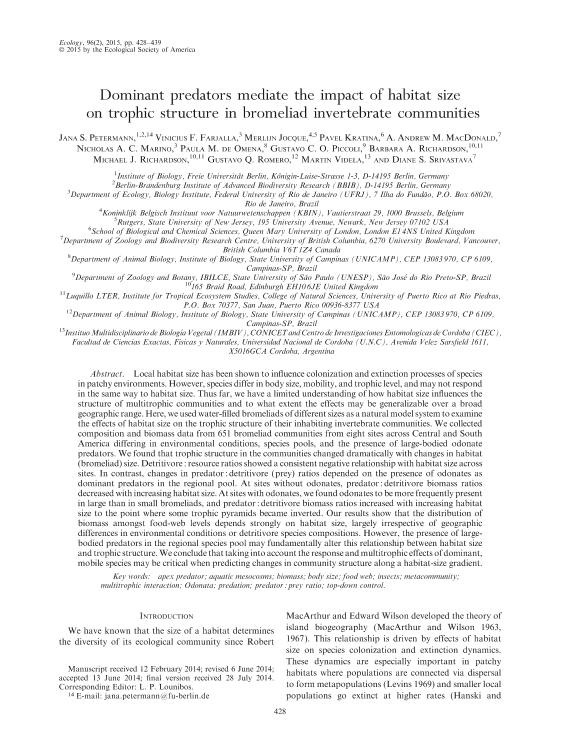Mostrar el registro sencillo del ítem
dc.contributor.author
Petermann, Jana S.
dc.contributor.author
Farjalla, Vinicius F.
dc.contributor.author
Jocque, Merlijn
dc.contributor.author
Kratina, Pavel
dc.contributor.author
Macdonald, Andrew
dc.contributor.author
Marino, Nicholas
dc.contributor.author
de Omena, Paula
dc.contributor.author
Piccoli, Gustavo
dc.contributor.author
Richardson, Michael
dc.contributor.author
Richardson, Barbara
dc.contributor.author
Romero, Gustavo
dc.contributor.author
Videla, Martin

dc.contributor.author
Srivastava, Diane
dc.date.available
2017-01-13T18:44:56Z
dc.date.issued
2014-07
dc.identifier.citation
Petermann, Jana S.; Farjalla, Vinicius F.; Jocque, Merlijn; Kratina, Pavel; Macdonald, Andrew; et al.; Dominant predators mediate the impact of habitat size on trophic structure in bromeliad invertebrate communities; Ecological Society Of America; Ecology; 96; 2; 7-2014; 428–439
dc.identifier.issn
0012-9658
dc.identifier.uri
http://hdl.handle.net/11336/11317
dc.description.abstract
Local habitat size has been shown to influence colonization and extinction processes of species in patchy environments. However, species differ in body size, mobility, and trophic level, and may not respond in the same way to habitat size. Thus far, we have a limited understanding of how habitat size influences the structure of multitrophic communities and to what extent the effects may be generalizable over a broad geographic range. Here, we used water-filled bromeliads of different sizes as a natural model system to examine the effects of habitat size on the trophic structure of their inhabiting invertebrate communities. We collected composition and biomass data from 651 bromeliad communities from eight sites across Central and South America differing in environmental conditions, species pools, and the presence of large-bodied odonate predators. We found that trophic structure in the communities changed dramatically with changes in habitat (bromeliad) size. Detritivore : resource ratios showed a consistent negative relationship with habitat size across sites. In contrast, changes in predator : detritivore (prey) ratios depended on the presence of odonates as dominant predators in the regional pool. At sites without odonates, predator : detritivore biomass ratios decreased with increasing habitat size. At sites with odonates, we found odonates to be more frequently present in large than in small bromeliads, and predator : detritivore biomass ratios increased with increasing habitat size to the point where some trophic pyramids became inverted. Our results show that the distribution of biomass amongst food-web levels depends strongly on habitat size, largely irrespective of geographic differences in environmental conditions or detritivore species compositions. However, the presence of large-bodied predators in the regional species pool may fundamentally alter this relationship between habitat size and trophic structure. We conclude that taking into account the response and multitrophic effects of dominant, mobile species may be critical when predicting changes in community structure along a habitat-size gradient.
dc.format
application/pdf
dc.language.iso
eng
dc.publisher
Ecological Society Of America

dc.rights
info:eu-repo/semantics/openAccess
dc.rights.uri
https://creativecommons.org/licenses/by-nc-sa/2.5/ar/
dc.subject
Apex Predator
dc.subject
Aquatic Mesocosms
dc.subject
Biomass
dc.subject
Body Size
dc.subject.classification
Ecología

dc.subject.classification
Ciencias Biológicas

dc.subject.classification
CIENCIAS NATURALES Y EXACTAS

dc.title
Dominant predators mediate the impact of habitat size on trophic structure in bromeliad invertebrate communities
dc.type
info:eu-repo/semantics/article
dc.type
info:ar-repo/semantics/artículo
dc.type
info:eu-repo/semantics/publishedVersion
dc.date.updated
2016-12-12T14:18:46Z
dc.journal.volume
96
dc.journal.number
2
dc.journal.pagination
428–439
dc.journal.pais
Estados Unidos

dc.description.fil
Fil: Petermann, Jana S.. Freie Universitat Berlin. Institute of Biology; Alemania
dc.description.fil
Fil: Farjalla, Vinicius F.. Universidade Federal do Rio de Janeiro; Brasil
dc.description.fil
Fil: Jocque, Merlijn. State University Of New Jersey; Estados Unidos
dc.description.fil
Fil: Kratina, Pavel. Queen Mary University Of London. School of Biological and Chemical Sciences; Reino Unido
dc.description.fil
Fil: Macdonald, Andrew. University Of British Columbia; Canadá
dc.description.fil
Fil: Marino, Nicholas. Universidade Federal do Rio de Janeiro; Brasil
dc.description.fil
Fil: de Omena, Paula. Universidade Estadual de Campinas; Brasil
dc.description.fil
Fil: Piccoli, Gustavo. Universidade de Sao Paulo; Brasil
dc.description.fil
Fil: Richardson, Michael. Universidad de Puerto Rico; Puerto Rico
dc.description.fil
Fil: Richardson, Barbara. Universidad de Puerto Rico; Puerto Rico
dc.description.fil
Fil: Romero, Gustavo. Universidade Estadual de Campinas; Brasil
dc.description.fil
Fil: Videla, Martin. Consejo Nacional de Investigaciones Científicas y Técnicas. Centro Científico Tecnológico Córdoba. Instituto Multidisciplinario de Biología Vegetal (p); Argentina. Universidad Nacional de Córdoba. Facultad de Ciencias Exactas, Físicas y Naturales. Centro de Investigaciones Entomológicas de Córdoba; Argentina
dc.description.fil
Fil: Srivastava, Diane. University Of British Columbia; Canadá
dc.journal.title
Ecology

dc.relation.alternativeid
info:eu-repo/semantics/altIdentifier/doi/http://dx.doi.org/10.1890/14-0304.1
dc.relation.alternativeid
info:eu-repo/semantics/altIdentifier/url/http://onlinelibrary.wiley.com/doi/10.1890/14-0304.1/abstract
Archivos asociados
